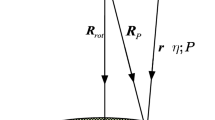Abstract
With the development of SAR imaging, the efficiency and rapidity of imaging algorithms have always been a research direction, and real-time imaging is a reflection of the speed of the imaging algorithm. For missile-borne SAR, real-time imaging is particularly important because it provides radar with a sense of the battlefield environment. In the case with a highly squinted angle, the azimuth space variance and the coupling between range and azimuth dimension will become serious in imaging, thus an azimuth frequency nonlinear chirp scaling (AFNCS) algorithm is proposed to solve this problem. Based on linear range walk correction, a novel chirp scaling algorithm is adopted to correct the range migration, and then a high-order phase filtering factor is introduced into the azimuth dimension frequency domain to decrease the azimuth space variance. In addition, combined with the SPECtral Analysis method, the image is focused on the Doppler domain. The AFNCS algorithm does not need complex mathematical calculations such as interpolation and can meet the real-time requirement of missile-borne SAR imaging. Simulation results illustrate the effectiveness of the proposed algorithm. The integration of the research in this paper and the deep learning will further pave the way for real-time SAR imaging applications in disaster monitoring, security and surveillance.





Similar content being viewed by others
References
Cumming, I.G., Wong, F.H.: Digital processing of synthetic aperture radar data: algorithm and implementation. Publishing house of electronics industry, Beijing (2005)
Wang, S.H., Sun, J., Phillips, P., Zhao, G.H., Zhang, Y.D.: Polarimetric synthetic aperture radar image segmentation by convolutional neural network using graphical processing units. J. Real Time Image Process. 15, 631–642 (2018)
Zhao, P.F., Deng, Y.K., Wang, W., Liu, D.C., Wang, R.: Azimuth ambiguity suppression for hybrid polarimetric synthetic aperture radar via waveform diversity. Remote Sens. 12(7), 1226 (2020)
An, D.X., Huang, X.T., Jin, T.: Extended nonlinear chirp scaling algorithm for high-resolution highly squint SAR data focusing. IEEE Trans. Geosci. Remote Sens. 50(9), 3595–3609 (2012)
Liu, G.G., Li, P., Tang, S.Y.: Focusing highly squinted data with motion errors based on modified non-linear chirp scaling. IET Radar Sonar Navig. 7, 568–578 (2013)
Sun, Z.C., Wu, J.J., Li, Z.Y., Huang, Y., Yang, J.: Highly squint SAR data focusing based on Keystone transform and Azimuth extended Nonlinear Chirp scaling. IEEE Geosci. Remote. Sens. Lett. 12(1), 145–149 (2017)
Zhang, L., Li, H.L., Qiao, Z.J., Xu, Z.W.: A fast BP algorithm with wavenumber spectrum fusion for high-resolution spotlight SAR imaging. IEEE Geosci. Remote. Sens. Lett. 11(9), 1460–1464 (2014)
Boag, A., Bresler, Y., Michielssen, E.: A multilevel domain decomposition algorithm for fast O(N2log(N)) reprojection of tomographic images. IEEE Trans Image Process. 9(9), 1573–1582 (2000)
Chen, S., Zhang, S., Zhao, H., Chen, Y.: A new Chirp scaling algorithm for highly squinted missle-borne SAR based on FrFt. IEEE J. Sel. Top. Appl. Earth Obs. Remote Sens. 8(8), 3977–3987 (2015)
Sun, X., Yeo, T.S., Zhang, C., Lu, Y., Kooi, P.S.: Time varying step-transform algorithm for high squint SAR imaging. IEEE Trans. Geosci. Remote Sens. 37(6), 2668–2677 (1999)
Yeo, T.S., Tan, N.L., Zhang, C., Lu, Y.: A new subaperture approach to high squint SAR processing. IEEE Trans. Geosci. Remote Sens. 39(5), 954–968 (2001)
Li, G., Ma, Y., Shi, L., Hou, J.Q.: KT and azimuth sub-region deramp-based high-squint SAR imaging algorithm mounted on manoeuvring platforms. IET Radar Sonar Navig. 14, 388–398 (2020)
Xiong, T., Xing, M., Xia, X.G., Bao, Z.: New applications of omega-k algorithm for SAR data processing using effective wavelength at high squint. IEEE Trans. Geosci. Remote Sens. 51(5), 3156–3169 (2013)
Tang, S.Y., Zhang, L.R., Guo, P., Zhao, Y.H.: An omega-K algorithm for highly squinted missile-borne SAR with constant acceleration. IEEE Geosci. Remote Sens. Lett. 11, 1569–1573 (2014)
Moreira, A., Mittermayer, J., Scheiber, R.: Extended chirp scaling algorithm for air- and spaceborne SAR data processing in stripmap and scan SAR imaging modes. IEEE Trans. Geosci. Remote Sens. 34(5), 1123–1136 (1996)
Davidson, G.W., Cumming, I.G., Ito, M.R.: A chirp scaling approach for processing squint mode SAR data. IEEE Trans. Aerosp. Electron. Syst. 32(1), 121–133 (1996)
Acknowledgements
This research was funded by the National Natural Science Foundation of China (62071359), China Postdoctoral Science Foundation (2016M602770), Scientific Research Program Funded by Shaanxi Provincial Education Department (19JK0673), the Natural Science Basic Research Plan in Shaanxi Province of China (2019JQ-405), Postdoctoral Science Foundation in Shaanxi Province and the Fundamental Research Funds for the Central Universities.
Author information
Authors and Affiliations
Corresponding author
Additional information
Publisher's Note
Springer Nature remains neutral with regard to jurisdictional claims in published maps and institutional affiliations.
Rights and permissions
About this article
Cite this article
Zhang, Y., Qu, T. Focusing highly squinted missile-borne SAR data using azimuth frequency nonlinear chirp scaling algorithm. J Real-Time Image Proc 18, 1301–1308 (2021). https://doi.org/10.1007/s11554-021-01135-6
Received:
Accepted:
Published:
Issue Date:
DOI: https://doi.org/10.1007/s11554-021-01135-6




